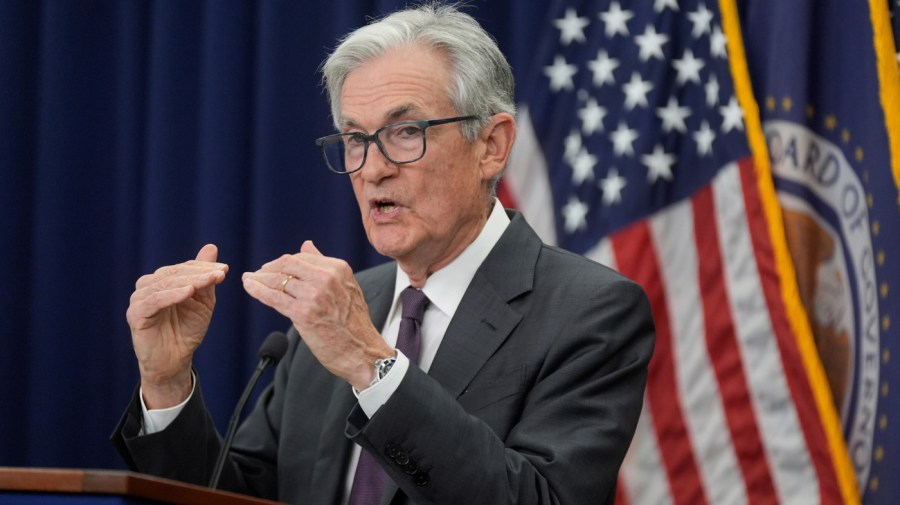Jerome Powell stays even-keeled at Jackson Hole

Heading into the Jackson Hole Economic Summit, investors focused on how Jerome Powell’s message might differ from his assessment of the economy at the July Federal Open Market Committee meeting.
Powell indicated then that the decision to keep the federal funds rate unchanged at 4.25 to 4.50 percent reflected the Fed’s view that labor market conditions were solid but inflation was above the Fed’s 2 percent long-term goal.
In the press conference, he indicated that President Trump’s tariffs were beginning to create price pressures, and it would take time to determine whether they would be a one-time increase or more persistent.
Two members of the Federal Open Market Committee, Christopher Waller and Michelle Bowman, dissented at the meeting, favoring a 25 basis-point cut in the funds rate. This marked the first committee dissents since 1993.
Waller explained his reasoning was that central banks should look through tariffs as “one-off increases in the price level.” Bowman indicated she had gained confidence that tariffs will not present a persistent shock to inflation.
Since then, two developments have caused bond traders to anticipate that the Fed will begin to ease monetary policy in September.
The first was the July jobs report, which came in softer than expected and was accompanied by downward revisions of jobs for the two prior months totaling 260,000. This altered investors’ perceptions about the strength of the jobs market, and the bond market priced in two rate cuts of 25 basis points in the balance of this year.
The second development was the July Consumer Price Index report that showed a smaller than expected rise in inflation. It caused some observers to anticipate that the Fed could lower the funds rate by 50 basis points in September.
However, these hopes faded when the July producer price index posted a 0.9 percent month-over-month increase and a 3.7 percent year-over-year rise.
Meanwhile, President Trump escalated his sharp critiques of the Fed chair, writing “Jerome ‘Too Late’ Powell must NOW lower the rate,” in a Truth Social post.
Amid these developments, Powell acknowledged at Jackson Hole that the labor market was softer than the Fed thought in July, but he did not signal what the Fed might do in September.
My take is the decision will hinge on upcoming data about how the economy performed in August. If the job market stayed soft and inflation did not accelerate, the likelihood is the Fed will ease monetary policy by 25 basis points. The rationale would be that a weak jobs market posed a greater risk to the economy than a tariff-induced hike in prices.
Beyond the decision about interest rates, Powell is also expected to unveil the Fed’s new framework for setting monetary policy. This is significant, because it will set the stage for how the Fed bases its policy decisions going forth.
While President Trump has criticized the Fed for being too slow in lowering interest rates, this was not true during the onset of the COVID-19 pandemic. The Fed pulled out its playbook from the 2008 Financial Crisis, quickly lowering interest rates to zero and expanding its balance sheet as unemployment spiked.
This action, along with massive federal government programs, succeeded in pulling the economy out of what could have been a severe recession.
In comparison, the principal mistake the Fed made during Powell’s tenure was to hold off on tightening monetary policy in 2021, when inflation accelerated well beyond the Fed’s 2 percent target.
This partly reflected the Fed’s view at the time that inflation was mainly linked to supply-chain shortages that would be temporary. Instead, inflation became entrenched as it spread from the goods sector to services.
Although Powell appeared to recognize this after the Jackson Hole symposium in August 2021, the Fed waited until March 2022 to tighten monetary policy. It then had to play catch-up for the next 15 months as the funds rate went from zero to 5.5 percent.
In analyzing what went wrong, monetary economists have blamed the new policy framework the Fed adopted in 2020, known as Flexible Average Inflation Targeting . The framework shifted the Fed’s approach to aim for inflation to average 2 percent over time, while allowing for it to run above 2 percent to compensate for periods of below-target inflation.
The shift occurred at a time when inflation had been persistently low both in the U.S. and abroad, and Fed officials worried about reaching the zero lower boundary for interest rates. Critics contend that the policy change contributed to an asymmetric response to inflation, and it did not address how overshoots would be handled.
In practice, the Fed paid greater attention to lowering unemployment than tackling inflation, and it underestimated the impact that massive fiscal and monetary stimulus had in boosting aggregate demand.
I believe this helps to explain why Powell is wary of easing monetary policy when inflation is above the Fed’s target and moving in the wrong direction.
Looking ahead, one of the main challenges the Fed faces is whether it will be able to preserve its independence when President Trump is determined to exert greater influence in monetary policy making.
Trump’s decision to appoint Stephen Miran, currently chair of the Council of Economic Advisors, to fill a temporary vacancy on the Board of Governors, could provide an early test.
The reason: Miran has criticized the Fed for what he described as “groupthink” on monetary policy, as well as mission creep and regulatory mistakes. He could also become a vocal advocate for change at the Federal Reserve.
Meanwhile, there is little to indicate that Powell will change his stoic posture as his tenure as Fed chair winds down.
Nicholas Sargen, Ph.D., is an economic consultant to Fort Washington Investment Advisors and is affiliated with the University of Virginia’s Darden School of Business. He has authored three books including “Investing in the Trump Era: How Economic Policies Impact Financial Markets.”